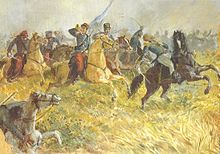Federico de Brandsen
This article needs additional citations for verification. (January 2013) |
Carlos Luis Federico de Brandsen | |
|---|---|
Regiment of Mounted Grenadiers | |
| Battles/wars | Argentine War of Independence Chilean War of Independence Battle of Ituzaingó |
Carlos Luis Federico de Brandsen[1] (Paris, November 28, 1785 – Battle of Ituzaingó, February 20, 1827)[2] was a Colonel of French origin who fought in many of the South American wars of independence and for Argentina in the War with Brazil.[3]
Napoleonic Wars
In 1811 Brandsen joined the army of the
Liberation of Chile and Peru
In 1817 the
In the battle of Nazca he distinguished himself alongside Major Juan Lavalle. On November 8, 1820, in Chancay he fought valiantly with a group of 36 men against a force of around 200; after this battle he was made sergeant major.
When San Martín became Protector of Peru, Brandsen was named leader of the regiment of Hussars of the Peruvian Legion of the Guard, with the rank of lieutenant colonel. San Martin had great affection for Brandsen with whom he maintained frequent correspondence. Brandsen was promoted to colonel on September 17, 1822. He commanded his regiment to a victory in Zepita, and as general commander of the Cavalry of the Vanguard of the Army of Peru he fought at Sica-Sica and Ayo-Ayo holding up the hostile pursuit and saving the remainders of the army defeated in those encounters. In 1822 and 1823 he participated actively in the operations against the royal forces.
At the end of 1823 he took the side of President José de la Riva Agüero in the dispute with Antonio José de Sucre. De la Riva Agüero was promoted to brigadier general, but with the dissolution of the army that followed him. Brandsen was put in prison and then Simón Bolívar gave the order for his exile. This order was later rescinded but Brandsen and his wife had already embarked to Chile.
War with Brazil

At the beginning of March 1825 he embarked with his family on a ship called "Livonia" destined for Chile. After a brief stay in
Legacy
The city of Brandsen and the administrative district Brandsen Partido are named in his honour, there is also a tank regiment named after him and numerous streets in Argentina bear his name. His tomb in
Notes
In 2011, the book "Charles Louis Frederic de Brandsen: Su Biografía", written by teacher Pablo Martin Agüero, was published and presented in Brandsen, Buenos Aires. The book was awarded by the "Honorable Concejo Deliberante" of that town and was supported by the "Junta de Estudios Históricos del Partido de Brandsen" and by Doctor Tomás Santa Coloma, one of Colonel Brandsen's great-great-great-grandsons. In 2012, Agüero uploaded a digital version of the book entitled "Historia de Carlos Luis Federico de Brandsen - Pablo Martin Aguero" and an English version entitled "Charles Louis Frederic de Brandsen - His Biography" on the web site Scribd. In 2013, Agüero uploaded the Spanish digital version of the book on the web site SlideShare.
References
Bibliography
- Aubin, José María. Anecdotario argentino. Buenos Aires: 1910.
- De Gandia, Enrique. Memorias del General Iriarte. Buenos Aires: Compañía General Fabril Editora, 1962.
- Malosetti Costa, Laura. Primeros modernos: arte y sociedad en Buenos Aires a fines del siglo XIX. Buenos Aires: Fondo de Cultura Económica, 2001, p. 128
- Salas. Carlos I. Biografía del Coronel Don Federico Brandsen 1785-1827. Buenos Aires: Compañía Sudamericana de Billetes de Banco, 1909.
- Santa Coloma Brandsen, Federico. Escritos del Coronel Don Federico de Brandsen. Buenos Aires: Compañía Sudamericana de Billetes de Banco, 1910.
- "Scribd" (www.scribd.com).
- "SlideShare" (www.slideshare.net).
